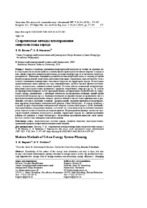| dc.contributor.author | Бугаева, Т. М. | |
| dc.contributor.author | Новикова, О. В. | |
| dc.coverage.spatial | Минск | ru |
| dc.date.accessioned | 2019-07-22T11:02:12Z | |
| dc.date.available | 2019-07-22T11:02:12Z | |
| dc.date.issued | 2019 | |
| dc.identifier.citation | Бугаева, Т. М. Современные методы планирования энергосистемы города = Modern Methods of Urban Energy System Planning / Т. М. Бугаева, О. В. Новикова // Энергетика. Известия высших учебных заведений и энергетических объединений СНГ. – 2019. – № 4. – С. 377-387. | ru |
| dc.identifier.uri | https://rep.bntu.by/handle/data/55125 | |
| dc.description.abstract | Знания о характере изменения энергетической нагрузки не только во времени, но и в пространстве позволят добиться оптимальной структуры источников энергии в городе и тем самым сократить непроизводительные расходы энергоресурсов и повысить энергоэффективность. Изменение парадигмы развития систем энергоснабжения в сторону развития малой распределенной энергетики, интеллектуализации, управления спросом требует более точного понимания планируемых локальных нагрузок на территории города. В настоящее время получение таких данных все еще затруднительно, требует анализа многих источников и, следовательно, занимает немало времени. В статье описан возможный алгоритм формирования пространственно-временного профиля потребления энергоресурсов. В основе дезагрегирования нагрузки лежит пространственное распределение потребителей по территории города, оцениваемое с помощью плотности распределения площади зданий групп потребителей энергоресурсов. Размерность модели не ограничена как во временном, так и в пространственном разрешении: модель является гибкой и может быть адаптирована к различным случаям и местным условиям. Предложенный алгоритм применен к моделированию профиля потребления электрической энергии Санкт-Петербурга. В основе профиля – годовой график потребления электрической энергии в почасовом разрезе (8760 значений). Пространственное разрешение модели составляет от сотен метров до нескольких километров и зависит только от наличия исходных данных. В приведенном примере в качестве пространственной единицы используется деление территории города на административные районы (18 районов в Санкт-Петербурге). Полученные результаты показали свою логичность и соответствие эмпирическим наблюдениям. | ru |
| dc.language.iso | ru | ru |
| dc.publisher | БНТУ | ru |
| dc.title | Современные методы планирования энергосистемы города | ru |
| dc.title.alternative | Modern Methods of Urban Energy System Planning | ru |
| dc.type | Article | ru |
| dc.identifier.doi | 10.21122/1029-7448-2019-62-4-377-387 | |
| local.description.annotation | Knowledge of the nature of the energy load alterations not only in time, but also in space will allow achieving the optimal structure of energy sources in the city and thereby reducing unproductive energy costs of energy resources and increasing energy efficiency. Changing the paradigm of power supply systems development towards the development of small distributed power production, intellectualization and demand management requires a more accurate understanding of the planned local loads in the city. At present it is still difficult to obtain such data; it requires analysis of many sources and, consequently, takes a lot of time. The article presents a possible algorithm of formation of the space-time profile of energy resources consumption. At the heart of the load disaggregation there is a spatial distribution of consumers in the city, estimated by the density of the distribution area of buildings of energy consumer groups. The dimension of the model is not limited in both temporal and spatial resolution: the model is flexible and can be adapted to different cases and local conditions. The proposed algorithm has been applied to the modeling of the profile of electricity consumption in St. Petersburg. The profile is based on an annual graph of electricity consumption by hour (8760 values). The spatial resolution of the model ranges from hundreds of meters to several kilometers and depends only on the availability of initial data. In the example, the division of the city territory into administrative districts (18 districts of St. Petersburg) is used as a spatial unit. The obtained results showed their logicality and compliance with empirical observations. | ru |

